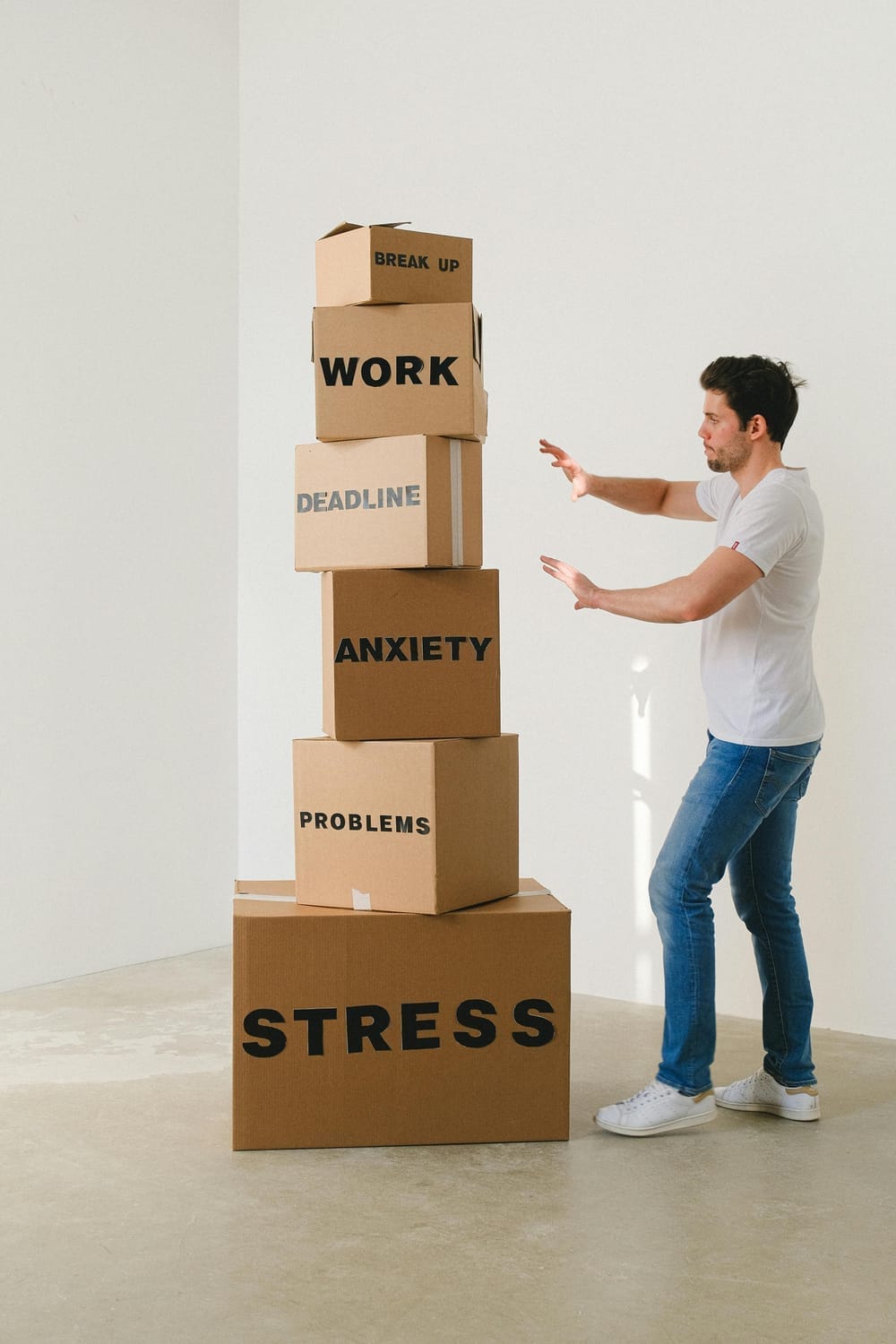

Mindful
Meditation
Unlocked
"Quiet the Mind. Unlock the
Present. Discover Mindfulness
That Transforms."
Quick Tips to Relieve Stress at Work
Ever feel overwhelmed by a tight deadline, a tough boss, or a challenging coworker? Stress can quickly take over, impacting both your performance and your health. In today’s fast-paced world, it's more important than ever to have effective strategies for managing workplace stress.
Fortunately, there are easy, actionable ways to cut down stress and boost your mood. With just a few simple habits added to your routine, you can improve focus, feel more energetic, and create a more positive work environment. This article shares practical, quick stress relief techniques to help you stay calm, focused, and in control—even on your busiest days.
Key Takeaways
Discover simple stress relief techniques to improve your workday
Learn how to reduce stress and boost your mood
Find out how to create a more positive work environment
Get tips on managing stress in the workplace
Improve your focus and increase your energy levels
Understanding Workplace Stress and Its Impact
Feeling overwhelmed at work is common but understanding what causes stress is the first step towards taking back control.
Common Causes of Stress in the Workplace
There are many potential stress triggers at work—tight deadlines, high workloads, lack of autonomy, difficult coworkers, and unclear expectations. Even subtle issues like poor lighting, constant noise, or lack of recognition can chip away at your well-being over time.
In some cases, it's the constant mental multitasking or pressure to be “always on” that creates hidden stress. Modern work environments often blur the line between professional and personal life, making it harder to fully unplug.
Recognizing these sources—both big and small—can help you be more proactive about addressing them.
How Stress Affects Your Productivity and Health
Chronic stress isn’t just uncomfortable—it’s harmful. It reduces concentration, decision-making ability, and creativity. It can lead to burnout, a state of emotional exhaustion that makes work feel meaningless or overwhelming.
Physically, long-term stress may cause high blood pressure, digestive issues, poor sleep, frequent headaches, and a weakened immune system. You may even notice behavioral changes—like irritability, withdrawal, or increased mistakes at work.
Stress isn’t just a feeling—it’s a signal that something needs to change.
Recognizing Your Own Stress Triggers
Everyone has his or her own stress triggers. For one, it could be last-minute project changes. For another, it could be too many meetings or unclear instructions.
Take a few minutes to reflect on your recent workdays. What situations made you feel tense or frustrated? Were there certain people or tasks that drained your energy?
Keeping a simple stress journal for a week can be revealing. By identifying your patterns, you can better manage—or even prevent—certain stressors before they take hold.
How to Relieve Stress Quickly at Work: Physical Techniques
The modern workplace can be a leading source of mental as well as physical stress. But with the right methods, you can calm stress in minutes-even from your desk.
Quick Breathing Exercises for Immediate Calm
Your breath is one of the fastest tools you have for calming the nervous system. In moments of stress, our breathing often becomes shallow, feeding feelings of anxiety. Conscious breathing turns that response around and sends calming messages to your brain.
4-7-8 Breathing Technique
Inhale for four seconds, hold for seven, and exhale slowly for eight. This pattern helps slow the heart rate and triggers the body’s relaxation response. Two or three repetitions are usually sufficient to bring about a noticeable shift in how you feel.
Box Breathing Method
Or "square breathing," it is a four-even-count method: inhale for four, hold for four, exhale for four, hold again for four. Used by athletes and even Navy SEALs, box breathing helps restore balance and sharpens clear thinking in high-pressure situations.
Deep Diaphragmatic Breathing
This technique is all about breathing deeply into your stomach (not your chest), holding for a second, and exhaling fully. Place one hand on your stomach to sense it rise and fall.
Just five minutes a day can reduce cortisol levels and improve focus.
These breathing practices may seem simple, but with consistency, they can train your body to respond more calmly to everyday challenges.
Desk-Friendly Stretches and Movements
Sitting for long periods can lead to muscle tension, stiffness, and fatigue. Simple stretches can refresh your body and mind.
Try these:
Shoulder rolls: Loosen tight neck and shoulder muscles.
Neck tilts: Gently stretch the sides of your neck by tilting your head left and right.
Wrist extensions: Stretch your arms out, palms forward, and gently pull back on your fingers to relieve typing strain.
Even standing up and walking for two minutes once an hour can increase circulation and reduce brain fog.
Progressive Muscle Relaxation at Your Desk
This technique involves tensing and relaxing different muscle groups, one at a time, to release built-up tension.
Start at your toes and work upward:
Tense your muscles for five seconds, then release for 10.
Move to your calves, thighs, abdomen, hands, and shoulders.
This method not only calms the body but also brings you into the present moment—helping you reset after a stressful meeting or task.
Mental Techniques to Manage Workplace Stress
While your body needs physical relief from tension, your mind needs mental clarity. The following strategies help build mental resilience and reduce emotional strain.
Mindfulness and Meditation Practices
Mindfulness means being fully present in the moment without judgment.
Meditation is a structured way to practice mindfulness and train your attention.
You don’t need to sit cross-legged in silence for 30 minutes. Even just two to five minutes of quiet, focused breathing or body awareness can help.
For example:
Take a "mindful minute" between meetings. Close your eyes, notice your breath, and observe any tension in your body.
Try a brief body scan meditation at your desk—start from your head and move downward, observing sensations without trying to change anything.
Practicing mindfulness regularly helps create a buffer between external stressors and your internal reaction. Over time, you'll find that you respond more calmly to challenges that once triggered anxiety.
Cognitive Reframing Techniques
Cognitive reframing means changing the way you interpret situations. Instead of thinking, “This deadline is impossible,” you might reframe it as “This is a chance to prove how resourceful I can be.”
Steps to try:
1. Notice the negative thought.
2. Ask: Is this thought helpful or true?
3. Replace it with a more balanced version.
Over time, reframing builds mental flexibility and reduces the tendency to overestimate problems.
Visualization Exercises for Stress Relief
Your brain often responds to imagined experiences as if they’re real. Guided imagery and visualization can transport your mind to a calm setting—even if you’re stuck in a busy office.

Try this:
Close your eyes and picture a calm place (quiet room, beach, forest).
Engage all your senses—what do you hear, what do you see, what do you feel?
Spend 2–3 minutes immersed in this space before switching back to work.
This quick mental escape can help reset your nervous system and restore emotional balance.
Organizational Strategies to Reduce Workplace Stress
How you organize your time, work, and office space can significantly affect your stress levels.
Time Management and Prioritization Tactics
Disorganization is a major source of workplace stress. Two powerful frameworks can help:
The Pomodoro Technique
Work for 25 minutes, then take a 5-minute break. After four repetitions, take a longer 15–30-minute break.
This method keeps you focused, prevents burnout, and makes large tasks feel manageable.
Eisenhower Matrix
This tool helps you sort tasks into four categories:
Urgent & important: Do these now.
Important but not urgent: Schedule these.
Urgent but not important: Delegate if possible.
Neither: Consider eliminating.
This matrix helps clarify priorities, especially when everything feels “urgent.”
Setting Healthy Boundaries with Colleagues
Being a team player is great—but not at the cost of your well-being. Learn to say no respectfully, avoid overcommitting, and protect your off-hours.
Tips:
Let colleagues know when you're unavailable for non-urgent tasks.
Use autoresponders or status updates during deep focus time.
Describe your workload realistically and clearly.
Boundaries are not barriers—they're living in self-respect.
Creating a Stress-Reducing Workplace
A cluttered, noisy, or poorly lit workspace can increase tension.

Small tweaks make a big difference:
Add a plant or two for a natural calming effect.
Use noise-cancelling headphones or soft background music to minimize distractions.
Keep your space organized—clear surfaces can equal a clear mind.
Social Strategies for Coping with Stress in the Workplace
You don't have to manage stress alone. Human connection is a powerful antidote to workplace pressure.
Building a Support Network at Work
Cultivating supportive relationships at work can help you feel more grounded and less isolated.
Start by:
Checking in regularly with trusted coworkers.
Joining team chats or interest groups.
Contacting someone you admire or trust when you need an ear.
A brief vent or positive word from a co-worker can do more than you realize.
Effective Communication During Stressful Situations
Miscommunication fuels stress. In difficult conversations:
Stay calm.
Use "I" statements: "I felt overwhelmed when…"
Avoid blaming language.
Ask clarifying questions.
Clear communication fosters collaboration and reduces workplace tension.
When and How to Ask for Help
If your workload is becoming unmanageable, it’s okay to request assistance.
Be clear and proactive:
“I’m hitting a tight spot with my deadline. Would you be open to reviewing part of this?”
"I'd appreciate any feedback on how to tackle this issue efficiently.”
Asking for help isn't weakness—it's intelligent problem-solving.
| Social Strategy | Description | Benefits |
|---|---|---|
| Building a Support Network | Foster meaningful coworker relationships | Reduces isolation, improves collaboration |
| Effective Communication | Use calm, clear, respectful language | Solves issues quickly, lowers miscommunication stress |
| Asking for Help | Be honest and specific about your needs | Prevents burnout, improves performance and morale |
Conclusion: Creating Your Personal Stress Relief Plan
Now that you’ve explored practical ways to manage stress at work, it’s time to build your own custom plan.
Start with what resonates most:
Try a few deep breaths before a meeting.
Do a stretch at your desk after long calls.
Take mindful breaks to reset your mind.
Recognize your stress triggers, set boundaries, and use tools like the Pomodoro technique or meditation to stay balanced. Integrate habits into daily routines and see long-term change.
With regular effort, you’ll be better equipped to handle whatever your workday throws at you—calmly, confidently, and with clarity.
FAQ
What are some quick ways to relieve stress at work?
Try deep breathing exercises, desk stretches, and progressive muscle relaxation. Mindfulness and meditation can also help quickly ease work stress.
How can I manage my stress triggers in the workplace?
First, notice what stresses you out. It may be certain situations, people, or tasks. Then, find ways to deal with them, like taking breaks or setting boundaries.
What are some effective time management techniques to reduce stress?
Use the Pomodoro Technique and the Eisenhower Matrix. The Pomodoro Technique involves focused work followed by breaks. The Eisenhower Matrix helps one sort out work in terms of urgency and significance.
How can I create a stress-reducing workspace?
Reflect on the light, sound, and comfort factor in your working space. Adding plants, using a standing desk, or calming colors can make it more relaxing.
What is the function of a support system in managing workplace stress?
A support network at work is key. Talking over problems with managers or fellow workers will make you less alone and less tense.
Can mindfulness and meditation procedures really reduce stress?
Absolutely. Mindfulness and meditation help you to notice your thoughts and feelings more closely without judgment. This gives you space to respond instead of reacting, which is especially helpful during stressful periods at work.
Stay Mindful
Get updates & free mental wellness tips.
Hi 👋
Hope you are doing okay, Just want to let you know,
Some links on this site are affiliate links. We may earn a small commission if you make a purchase — at no extra cost to you.
Understand Your Mind.
Try our quick quizzes to learn more about your mental health.
Check these out









